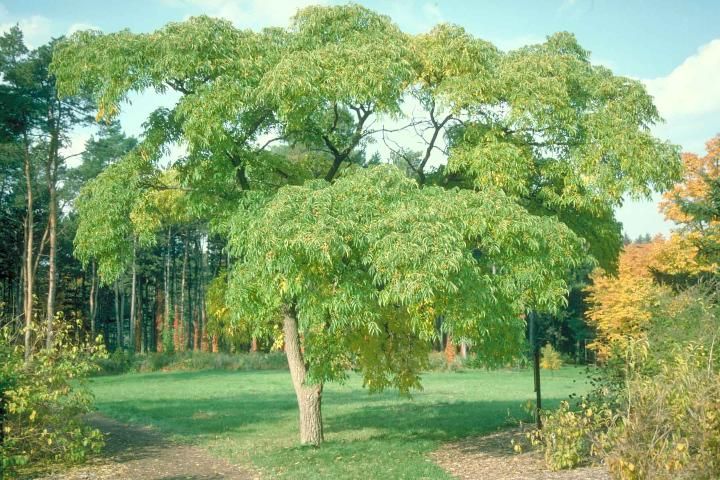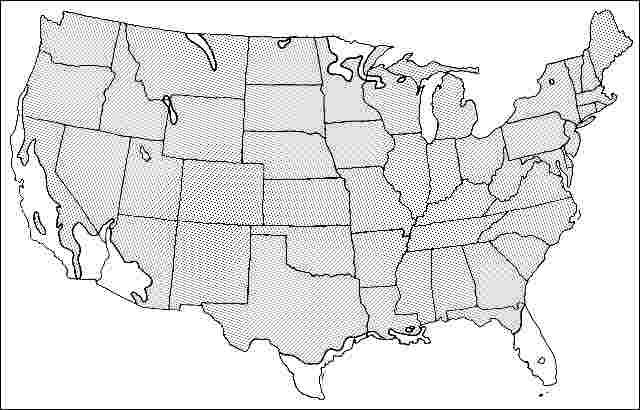Phellodendron amurense: Amur Corktree1
Introduction
Growing 30 to 40 feet tall with an equal or much greater spread, Amur Corktree has a short trunk and an open, rounded, spreading canopy which makes it ideal as a durable shade tree. Male clones can be used for street and parking lot planting because they produce no fruit. The deciduous, dark green, pinnately compound leaflets change to bronze and yellow in the fall before dropping. The insignificant yellow/green flowers appear in late May to early June on 2 to 3.5-inch-long panicles, and are followed by small black drupes which sometimes persist into winter, if not first devoured by birds. These black fruits give off a strong odor when crushed and create a mess on a sidewalk and some people may find it more desirable to only plant male trees (`Macho') which will not produce this fruit. The species can naturalize as seeds readily germinate in the landscape.

Credit: Ed Gilman
General Information
Scientific name: Phellodendron amurense
Pronunciation: fell-oh-DEN-drawn am-moor-EN-see
Common name(s): Amur Corktree, Chinese Corktree
Family: Rutaceae
USDA hardiness zones: 3B through 8B (Fig. 2)
Origin: not native to North America
Invasive potential: invasive non-native
Uses: specimen; shade; street without sidewalk; urban tolerant; highway median
Availability: somewhat available, may have to go out of the region to find the tree

Description
Height: 30 to 40 feet
Spread: 40 to 60 feet
Crown uniformity: irregular
Crown shape: vase, round, spreading
Crown density: open
Growth rate: moderate
Texture: medium
Foliage
Leaf arrangement: opposite/subopposite (Fig. 3)
Leaf type: odd-pinnately compound
Leaf margin: entire, undulate
Leaf shape: ovate, elliptic (oval)
Leaf venation: pinnate, reticulate
Leaf type and persistence: deciduous
Leaf blade length: 2 to 4 inches
Leaf color: green
Fall color: copper, yellow
Fall characteristic: showy

Flower
Flower color: white/cream/gray, green
Flower characteristics: not showy
Fruit
Fruit shape: oval
Fruit length: less than .5 inch, .5 to 1 inch
Fruit covering: fleshy
Fruit color: black, green
Fruit characteristics: attracts birds; showy; fruit/leaves a litter problem
Trunk and Branches
Trunk/bark/branches: branches droop; showy; typically multi-trunked; thorns
Pruning requirement: needed for strong structure
Breakage: resistant
Current year twig color: gray, brown
Current year twig thickness: thick
Wood specific gravity: unknown
Culture
Light requirement: full sun
Soil tolerances: clay; sand; loam; alkaline; acidic; occasionally wet; well-drained
Drought tolerance: high
Aerosol salt tolerance: moderate
Other
Roots: can form large surface roots
Winter interest: yes
Outstanding tree: yes
Ozone sensitivity: unknown
Verticillium wilt susceptibility: susceptible
Pest resistance: free of serious pests and diseases
Use and Management
The attractive grey/brown bark is deeply ridged and furrowed, and on mature trees it takes on a corky texture. Branches are usually borne low on the trunk, droop and grow horizontally forming a spreading habit. The shallow root system needs plenty of room to expand in order to establish the tree properly.
The fruitless (male) cultivar `Macho' has thick, leathery leaves and a more pleasing, upright-spreading growth form. `Macho' should be planted instead of the species due to its less spreading and less drooping habit which makes it more suited for street tree planting. Pruning usually is not required once good branch structure is established early in the life of the tree. Allow for adequate soil space for root development so they do not lift sidewalks and pavement. `Shademaster' is also fruitless and available in the trade.
Amur Corktree grows rapidly and prefers to be grown in full sun on deep, rich soil but will tolerate any soil, acid or alkaline. It tolerates wet soil and drought. Once highly recommended as a street and urban-tolerant tree, it does not appear to hold up to the rigors of city life under certain conditions, particularly restricted soil spaces (although the experts appear to disagree as to the tolerance of this tree to city life - the tree may be more sensitive to soil conditions than is commonly realized).
Propagation is by seed, which germinate readily.
Pests and Diseases
This tree is virtually pest-free.


